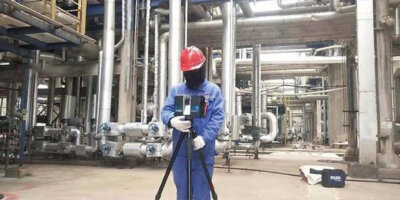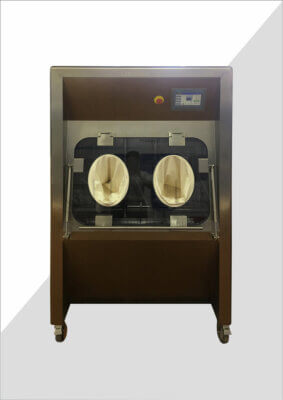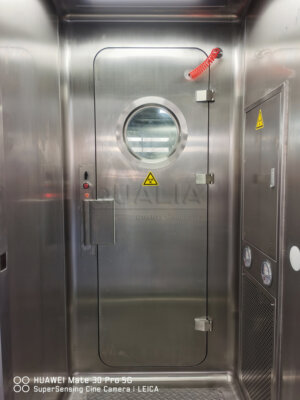Effluent Decontamination Systems (EDS) play a crucial role in managing hazardous waste in laboratories and healthcare facilities. As environmental concerns grow, the focus on energy efficiency in EDS design and operation has become paramount. This article explores the key considerations and strategies for maximizing energy efficiency in EDS, from initial design to day-to-day operations.
The energy efficiency of EDS systems impacts both environmental sustainability and operational costs. By implementing smart design choices and optimized operational practices, facilities can significantly reduce their energy consumption while maintaining the highest standards of waste decontamination. This article will delve into the latest technologies, best practices, and innovative approaches that are shaping the future of energy-efficient EDS solutions.
As we explore the world of energy-efficient EDS design and operation, we'll examine various aspects such as system components, process optimization, and emerging technologies. Understanding these elements is crucial for facility managers, engineers, and decision-makers looking to enhance their EDS performance while minimizing energy usage.
Energy efficiency in EDS design and operation is not just a cost-saving measure but a critical factor in reducing the environmental impact of waste management processes in high-containment facilities.
| Aspect | Traditional EDS | Energy-Efficient EDS |
|---|---|---|
| Heat Recovery | Limited or none | Extensive heat recovery systems |
| Insulation | Basic | Advanced thermal insulation |
| Control Systems | Manual or semi-automated | Fully automated with smart controls |
| Pump Efficiency | Standard efficiency | High-efficiency, variable speed pumps |
| Waste Segregation | Basic | Advanced segregation for optimized treatment |
| Monitoring | Periodic checks | Real-time monitoring and data analytics |
How can EDS design impact overall energy consumption?
The design phase of an Effluent Decontamination System is critical in determining its long-term energy efficiency. Thoughtful consideration of system components, layout, and integration can lead to significant energy savings over the lifetime of the system.
A well-designed EDS incorporates energy-efficient equipment, optimized piping layouts, and intelligent control systems. These elements work together to minimize energy losses and maximize the effectiveness of the decontamination process.
By focusing on energy efficiency from the outset, designers can create systems that not only meet regulatory requirements but also contribute to the overall sustainability goals of the facility. This approach often leads to reduced operational costs and a smaller carbon footprint.
Proper EDS design can reduce energy consumption by up to 30% compared to conventional systems, without compromising decontamination efficacy.
| Design Element | Energy Saving Potential |
|---|---|
| Heat Exchangers | 15-25% |
| Insulation | 5-10% |
| Pump Selection | 10-20% |
| Control Systems | 10-15% |
What role does heat recovery play in EDS energy efficiency?
Heat recovery is a cornerstone of energy-efficient EDS design. By capturing and reusing thermal energy that would otherwise be wasted, facilities can significantly reduce their overall energy consumption.
Effective heat recovery systems in EDS can reclaim heat from treated effluent and use it to preheat incoming waste streams. This process not only reduces the energy required for heating but also helps in cooling treated effluent before discharge, meeting environmental regulations more efficiently.
Advanced heat recovery technologies, such as plate heat exchangers and thermal storage systems, are becoming increasingly popular in EDS design. These systems can adapt to varying waste volumes and temperatures, ensuring optimal energy recovery under different operating conditions.
Implementing comprehensive heat recovery in EDS can lead to energy savings of up to 40% in the heating process, substantially reducing operational costs and environmental impact.
| Heat Recovery Method | Efficiency Range |
|---|---|
| Plate Heat Exchangers | 60-80% |
| Thermal Storage | 70-90% |
| Waste Heat Boilers | 65-85% |
How can automation and control systems optimize EDS energy use?
Automation and advanced control systems are revolutionizing the way EDS operates, offering unprecedented opportunities for energy optimization. These systems allow for real-time monitoring and adjustment of operational parameters, ensuring that the system always runs at peak efficiency.
Smart control systems can analyze input from various sensors, adjusting treatment processes based on the specific characteristics of the waste stream. This dynamic approach ensures that energy is used only when and where it's needed, avoiding unnecessary treatment steps and reducing overall energy consumption.
Moreover, predictive maintenance algorithms can identify potential issues before they lead to system inefficiencies or breakdowns. This proactive approach not only saves energy but also extends the lifespan of EDS components.
Advanced automation and control systems can reduce EDS energy consumption by up to 25% while improving treatment consistency and reliability.
| Control Feature | Energy Saving Potential |
|---|---|
| Dynamic Process Adjustment | 10-15% |
| Predictive Maintenance | 5-10% |
| Load Balancing | 8-12% |
| Real-time Monitoring | 7-10% |
What impact does waste segregation have on EDS energy efficiency?
Proper waste segregation is often overlooked as an energy efficiency strategy, but it can have a significant impact on EDS performance. By segregating waste streams based on their characteristics and treatment requirements, facilities can optimize the decontamination process for each type of waste.
Effective segregation allows for targeted treatment, reducing the energy needed for overtreatment of less hazardous waste streams. It also enables the use of specialized treatment processes that may be more energy-efficient for specific types of waste.
Furthermore, waste segregation can facilitate the recovery of valuable resources and reduce the overall volume of waste requiring intensive treatment, leading to additional energy savings in the EDS process.
Implementing comprehensive waste segregation strategies can lead to a 15-20% reduction in EDS energy consumption while improving overall treatment efficacy.
| Waste Type | Recommended Treatment | Energy Saving Potential |
|---|---|---|
| Low-risk Effluent | Chemical Treatment | 20-30% |
| High-organic Content | Biological Treatment | 15-25% |
| Heavy Metal Contaminated | Ion Exchange | 10-20% |
| Radioactive Waste | Specialized Processes | 5-15% |
How do pump selection and operation affect EDS energy efficiency?
Pumps are the workhorses of any EDS, responsible for moving waste through various treatment stages. The selection and operation of these pumps can have a significant impact on the overall energy efficiency of the system.
High-efficiency pumps, coupled with variable frequency drives (VFDs), allow for precise control of flow rates and pressure. This flexibility ensures that pumps operate at their most efficient point, regardless of variations in waste volume or treatment requirements.
Proper sizing of pumps is equally crucial. Oversized pumps not only consume more energy than necessary but can also lead to increased wear and maintenance issues. Regular maintenance and monitoring of pump performance can help identify and address inefficiencies promptly.
Upgrading to high-efficiency pumps with VFDs can reduce pumping-related energy consumption in EDS by up to 50%, with additional benefits in system longevity and reduced maintenance costs.
| Pump Feature | Energy Saving Potential |
|---|---|
| High-efficiency Motors | 10-15% |
| Variable Frequency Drives | 20-40% |
| Proper Sizing | 15-25% |
| Regular Maintenance | 5-10% |
What role does insulation play in EDS energy efficiency?
Proper insulation is a fundamental yet often underestimated aspect of energy-efficient EDS design. Effective insulation minimizes heat loss throughout the system, reducing the energy required to maintain optimal treatment temperatures.
Advanced insulation materials and techniques can be applied to pipes, tanks, and treatment vessels to create a thermal barrier. This not only conserves energy but also helps maintain consistent temperatures, which is crucial for the efficacy of many treatment processes.
In addition to traditional insulation, innovative solutions such as vacuum-insulated panels and aerogel-based materials are pushing the boundaries of thermal efficiency in EDS applications.
Implementing comprehensive insulation strategies in EDS can reduce heat loss by up to 90%, translating to significant energy savings and improved process stability.
| Insulation Type | Thermal Conductivity (W/mK) | Energy Saving Potential |
|---|---|---|
| Fiberglass | 0.03-0.04 | 60-70% |
| Polyurethane Foam | 0.02-0.03 | 70-80% |
| Aerogel | 0.013-0.014 | 80-90% |
| Vacuum Insulated Panels | 0.004-0.006 | 85-95% |
How can emerging technologies further enhance EDS energy efficiency?
The field of EDS is constantly evolving, with new technologies promising even greater energy efficiency. From advanced membrane filtration systems to cutting-edge oxidation processes, these innovations are reshaping the landscape of effluent decontamination.
One particularly promising area is the integration of renewable energy sources directly into EDS operations. Solar thermal systems, for instance, can provide a significant portion of the heat required for treatment processes, reducing reliance on traditional energy sources.
Another exciting development is the use of artificial intelligence and machine learning algorithms to optimize EDS operations in real-time. These systems can analyze vast amounts of data to identify patterns and opportunities for energy savings that might be missed by human operators.
Emerging technologies in EDS design and operation have the potential to reduce energy consumption by up to 60% compared to current best practices, paving the way for truly sustainable waste management solutions.
| Technology | Energy Saving Potential | Implementation Complexity |
|---|---|---|
| Advanced Membranes | 30-40% | Medium |
| Solar Thermal Integration | 40-50% | High |
| AI-driven Optimization | 20-30% | Medium |
| Electrochemical Treatment | 25-35% | Medium |
In conclusion, energy efficiency in EDS design and operation is a multifaceted challenge that requires a holistic approach. From the initial system design to day-to-day operations, there are numerous opportunities to optimize energy use without compromising treatment efficacy. By incorporating advanced technologies, smart control systems, and innovative design principles, facilities can significantly reduce their energy consumption and environmental impact.
As regulations become more stringent and environmental concerns more pressing, the importance of energy-efficient EDS solutions will only grow. Facilities that invest in these technologies and practices now will be well-positioned to meet future challenges while benefiting from reduced operational costs and improved sustainability profiles.
The journey towards truly energy-efficient EDS is ongoing, with new innovations and best practices continually emerging. By staying informed and adopting a proactive approach to energy management, facilities can ensure that their EDS remains at the forefront of efficiency and effectiveness.
For those looking to implement or upgrade their EDS with a focus on energy efficiency, QUALIA offers cutting-edge solutions designed to meet the highest standards of performance and sustainability. Their expertise in energy-efficient EDS design and operation can help facilities achieve their environmental goals while ensuring compliance with all relevant regulations.
External Resources
Energy.gov – How-To Guide for Energy-Performance-Based Procurement – Comprehensive guide on incorporating energy efficiency into building design and operation.
ScienceDirect – Design strategies and measures to minimise operation energy use – Article discussing strategies for minimizing energy use in buildings under future climate scenarios.
EPA – Chapter 6: Energy Efficiency Program Best Practices – Outlines best practices for planning and implementing energy efficiency programs.
Energy.gov – Manage energy considerations in design – Resource on incorporating energy performance into facility and system design according to ISO 50001 standards.
ASHRAE – HVAC Modeling and Simulation: A Comprehensive Guide – Guide on optimizing energy efficiency in HVAC system design through modeling and simulation.
Related Contents:
- Enhancing Safety in Vaccine Production: The Role of EDS
- Thermal Effluent Decontamination: Protecting Our Environment
- Optimizing EDS for Cleanroom Efficiency
- Modernizing Wastewater Treatment: Integrating EDS Systems
- Continuous Effluent Decontamination: Protecting Our Environment
- The Battle of Decon: Chemical vs. Thermal Methods
- Navigating the Complexities of High-Potency API Effluent Management
- Streamlining Effluent Decontamination: Continuous vs. Batch Processing
- Effluent Decontamination Systems: Safeguarding Malaysia’s Environment





























